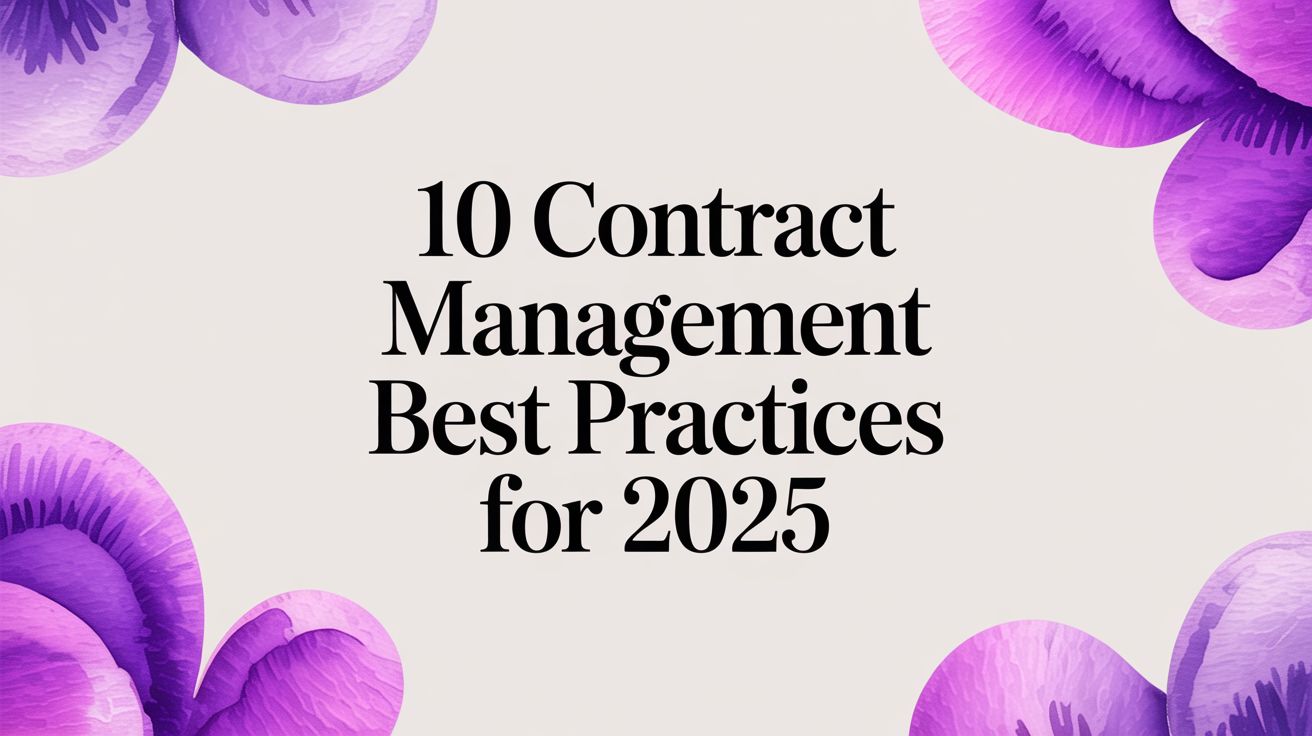10 Contract Management Best Practices for 2025

Table of Contents
- Centralized Contract Repository
- Automated Contract Lifecycle Management (CLM)
- Clear Contract Drafting Standards
- Pre-Execution Risk Assessment
- Defined Approval and Authorization Workflows
- Regular Contract Performance Monitoring
- Proactive Renewal and Expiration Management
- Cross-Functional Stakeholder Collaboration
- Compliance and Regulatory Framework Integration
- Contract Data Analytics and Business Intelligence
Effective contract management extends beyond acquiring signatures; it is a strategic business function that reduces risk, ensures compliance, and improves financial outcomes. Mismanaged contracts can cause operational friction, missed opportunities, and expensive legal disputes. Conversely, a disciplined approach transforms agreements from static documents into dynamic assets that contribute value throughout the organization. Implementing proven contract management best practices is crucial.
Ready To Fax?
Start sending faxes online in seconds with FaxZen - No account required
Send Fax Now 🚀As you refine your workflows, secure and reliable document transmission is essential, especially for legally binding agreements. FaxZen provides an online faxing solution that integrates smoothly into business processes, facilitating the handling of sensitive contracts and communications. Visit faxzen.com for more information.
This guide provides a prioritized, actionable checklist for mastering the contract lifecycle, covering ten critical practices. These include setting up a centralized repository, automating workflows, and defining clear approval processes. The guide is designed for practical application, with specific implementation details, real-world examples, and suggestions for small to midsize businesses and legal teams.
Learn to standardize contract intake and authoring, conduct pre-execution risk assessments, and securely manage document transmission, including faxing sensitive legal records. Post-execution strategies like performance monitoring, proactive renewal management, and data analytics for improved business intelligence are covered. By the end, you'll have a framework for building an efficient contract management system that supports sustainable growth. This practical roadmap helps you gain control over contractual obligations and opportunities.
Centralized Contract Repository
An effective contract management system begins with a centralized digital repository, moving beyond scattered storage to establish a secure, searchable "source of truth" for all agreements. Consolidating contracts and associated documents into one organized database eliminates information silos and ensures stakeholders have access to current and accurate versions.
This organizational discipline is vital for modern contract management, enabling teams to quickly locate documents, track key dates, and collectively analyze obligations. Small businesses might use structured systems like SharePoint or Google Drive, while legal practices may require a dedicated Contract Lifecycle Management (CLM) platform for security and compliance. A centralized system improves version control in contract processes.
Key Insight: A centralized repository acts as an intelligence hub, providing visibility into financial obligations, compliance risks, and renewal opportunities.
The impact of this practice is notable. For instance, Deloitte used centralized repositories to reduce contract review time by 40%. Shifting from chaotic storage to a unified system is key to advancing your contract management processes and mitigating risk.
Automated Contract Lifecycle Management (CLM)
Automated Contract Lifecycle Management (CLM) systems manage the entire contract journey, from request and authoring to execution, monitoring, and renewal. These platforms function as command centers, using workflow automation, e-signatures, and analytics to streamline processes. Automating tasks like approvals, reminders, and compliance checks reduces administrative burdens, minimizes errors, and accelerates contract cycles.
CLM platforms like Ironclad provide pre-approved clause libraries for faster drafting. The technology enhances security for document transmission and integrates with traditional methods like faxing; for those curious about emailing to a fax number, CLM integration creates a seamless workflow.
Key Insight: CLM is a strategic asset that turns static documents into dynamic, data-rich resources, offering visibility into obligations, risks, and performance.
The benefits of CLM are compelling. General Electric used a CLM system to reduce contract cycle time by 90%. Businesses can achieve similar gains in efficiency and control by replacing manual processes with automation.
Clear Contract Drafting Standards
Establishing standardized language, clauses, and formatting conventions is crucial for effective contract management. Moving beyond ad-hoc drafting, this practice creates a consistent framework for agreements. Clear drafting standards reduce ambiguity, minimize disputes, and make contracts easier to understand, negotiate, and enforce, reflecting the company's legal and business positions.
This discipline scales operations and maintains control over contractual risk, involving pre-approved templates and clause libraries. For law firms, this could mean standardized engagement letters and confidentiality clauses. Technology companies like Salesforce and Microsoft publish standard agreements, creating a consistent legal foundation for their products. For clarity in communications, see resources on crafting a fax cover sheet PDF template.
Key Insight: Standardized drafting establishes a strong, pre-vetted baseline, empowering faster, confident negotiations focused on unique deal points.
The impact is significant. According to World Commerce & Contracting, companies with standardized templates close deals 20-30% faster. This shift to a structured, standards-driven process is crucial for efficiency and legal exposure reduction.
Pre-Execution Risk Assessment
Conducting a thorough risk assessment before signing is a critical practice. This proactive step involves evaluating an agreement’s terms, obligations, and potential outcomes to identify and mitigate risks. By analyzing risk upfront, organizations prevent costly disputes, avoid unfavorable terms, and ensure commitments align with strategic goals.
This review transforms the pre-signature phase into a strategic business decision. For financial institutions, it means scrutinizing credit agreements for default risk and regulatory violations. For handling sensitive documents, see fax machine security information. This diligence ensures every contract is a well-understood business risk.
Key Insight: Pre-execution risk assessment is about understanding, quantifying, and accepting risk, shifting from reactive to proactive stances.
Implementing this reduces problematic agreements. For example, a mid-sized SaaS company can avoid financial exposure by catching an unlimited liability clause in a contract. Formalizing this review protects interests and builds sustainable relationships.
Defined Approval and Authorization Workflows
Advanced contract management requires governance over who can approve agreements. This practice establishes clear, documented approval hierarchies and workflows, defining who must review and sign off on contracts based on factors like value and risk. This approach prevents unauthorized commitments, ensures oversight, and protects from rogue spending.
Implementing these workflows moves from an ad-hoc system to a predictable, controlled function. For small businesses, this might mean a matrix where contracts over $10,000 require CEO approval. The structured process ensures contracts have proper review before becoming binding.
Key Insight: Defined approval workflows transform contract execution into a controlled, strategic function, aligning agreements with policy and financial limits.
The results are tangible. A mid-sized tech company reduced contract approval cycle from 12 days to three by implementing an automated workflow system. Enforcing proper review and preventing unauthorized agreements mitigates risk.
Regular Contract Performance Monitoring
Regular monitoring tracks whether parties meet obligations and if the agreement achieves its intended outcomes. This oversight moves contracts from static documents to active assets, identifying issues before they escalate and ensuring contracts deliver on promises.
This vigilant practice verifies compliance, manages risks, and informs decisions about renewals. For instance, a procurement team tracks vendor delivery against SLAs. Tracking ensures procurement contract terms are met.
Key Insight: Performance monitoring transforms contracts into active management tools, providing data to enforce accountability and optimize outcomes.
The benefits are clear. World Commerce & Contracting notes that actively managed contracts improve profitability by up to 9%. Systematically tracking performance ensures every contract contributes to the organization's success.
Proactive Renewal and Expiration Management
Proactive renewal management transforms renewal tracking into a strategic advantage, implementing processes to track dates, notify stakeholders, and make informed decisions before deadlines. This shifts from reactive stances to proactive ones, ensuring continuity and value optimization.
This approach prevents accidental lapses and creates opportunities to renegotiate terms. For a SaaS company, automated alerts help retain customers by engaging them before subscriptions end. The goal is thoughtful action rather than reactive pressure.
Key Insight: Proactive renewal management reclaims value, using renewals as opportunities to reassess needs and strengthen terms.
This practice delivers results. Fortune 500 companies use CLM software for alert windows, allowing renegotiation of multi-million dollar deals. Treating expirations as strategic checkpoints turns liabilities into assets.
Cross-Functional Stakeholder Collaboration
Effective contract management involves engaging stakeholders from various departments throughout the contract lifecycle. This breaks down silos, ensuring terms align with operational realities and broader business objectives.
This collaborative approach is key to modern contract management, preventing unfavorable terms and missed obligations. For a tech company, this means involving IT in technical specifications, finance in payment terms, and end-user departments in SLAs.
Key Insight: Cross-functional collaboration turns contracts into dynamic tools aligned with strategic goals, ensuring commitments are achievable.
The benefits are clear. Manufacturing firms involving supply chain, engineering, and quality assurance in agreements mitigate risks and ensure specifications are met, preventing costly delays. This shift to teamwork is essential for real-world value.
Compliance and Regulatory Framework Integration
Contract management demands adherence to legal, regulatory, and industry standards. Integrating a compliance framework ensures every agreement is lawful. This involves embedding controls, checks, and required clauses into contract processes to meet obligations like GDPR or FAR.
This proactive compliance approach is non-negotiable, mitigating risks and building trust. For European companies, it involves embedding GDPR-required clauses. A robust framework ensures better regulatory compliance.
Key Insight: Compliance is a continuous thread throughout the contract lifecycle, transforming contracts into strategic assets reinforcing ethical and legal standards.
This approach prevents compliance from being an afterthought. A financial services firm could implement workflow rules for mandatory OFAC checks, reducing regulatory risk. Embedding compliance is crucial for safeguarding the organization.
Contract Data Analytics and Business Intelligence
Contract management extends beyond storage and tracking, using analytics and business intelligence to extract insights, enabling data-driven decision-making and risk mitigation. This moves from reactive to predictive stances, identifying trends and opportunities.
Analytics answers critical questions. Procurement teams can analyze spend patterns for better pricing, while legal departments identify high-risk clauses to standardize templates. Companies like Icertis identify savings by analyzing commitments. This shift turns the contract lifecycle into a competitive advantage.
Key Insight: Contract analytics provide strategic insights, optimizing spend and informing future negotiations.
The goal is a feedback loop where past insights inform strategy. A Fortune 500 company might use analytics to benchmark payment terms, giving negotiators a data-backed position. This strategic use of data marks a mature contract management process.
Contract Management: Best Practices Comparison
| Best Practice | Implementation Complexity | Expected Outcomes |
|---|---|---|
| Centralized Repository | Moderate | Faster retrieval, version control |
| CLM Automation | High | Shorter cycle times, fewer errors |
| Drafting Standards | Low | Consistency, faster reviews |
| Risk Assessment | Moderate | Early risk detection, better decisions |
| Approval Workflows | Moderate | Clear accountability, less risk |
| Performance Monitoring | Moderate | Improved value, issue detection |
| Renewal Management | Low | No missed deadlines, better terms |
| Collaboration | Moderate | Holistic review, smoother implementation |
| Compliance Integration | High | Reduced regulatory risk, audit readiness |
| Data Analytics | High | Strategic insights, spend optimization |
Final Thoughts
Managing the contract lifecycle's complexities, from intake to archival, can be daunting. Yet, implementing a structured approach based on proven contract management best practices offers strategic advantages. Moving beyond disorganized storage transforms contracts into dynamic assets, driving value and fostering stronger relationships. Effective management is a continuous cycle of improvement, not a one-time project.
The practices detailed here serve as a blueprint for building this function within your organization. From centralized repositories to data analytics, each element plays a crucial role. A secure library ensures visibility and eliminates risks of lost agreements. Automation frees resources from manual tasks, allowing focus on strategic activities. Standardizing the drafting process and defining workflows create consistency and accelerate the lifecycle. Mastering these contract management best practices unlocks the full potential within agreements.
FAQ Section
What is the first step in implementing contract management best practices?
The first step is creating a centralized contract repository, the foundation for all other practices like automation and analytics. You cannot manage what you cannot find.
How does automation improve contract management?
Automation, typically through CLM software, reduces manual tasks, minimizes errors, and accelerates cycle times, creating efficient and auditable processes.
Why is cross-functional collaboration important for contracts?
Cross-functional collaboration is vital because contracts impact multiple departments. Involving stakeholders ensures terms are practical, financially sound, and aligned with goals.
Can small businesses benefit from these best practices?
Absolutely. Small businesses can implement many practices at scale, like using shared drives for a repository and setting calendar reminders for renewals, improving management significantly.
How do contract analytics provide business value?
Contract analytics transform static data into actionable intelligence, identifying cost-saving opportunities, mitigating risks, and gaining leverage for negotiations.
Related Articles
What is an Online Fax and How Does it Work?
How to Send a Fax from a Computer (Windows and Mac)
How Much Does it Cost to Send a Fax?



